OBJECTIVES
INTRODUCTION
Roughness is a measure of the texture of a surface. It is quantified by the vertical deviations of a real surface from its ideal form. If these deviations are large, the surface is rough; if they are small the surface is smooth. Roughness is typically considered to be the high frequency, short wavelength component of a measured surface (see surface metrology).Roughness plays an important role in determining how a real object will interact with its environment. Rough surfaces usually wear more quickly and have higher friction coefficients than smooth surfaces. Roughness is often a good predictor of the performance of a mechanical component, since irregularities in the surface may form nucleation sites for cracks or corrosion. Although roughness is usually undesirable, it is difficult and expensive to control in manufacturing. Decreasing the roughness of a surface will usually increase exponentially its manufacturing costs. This often results in a trade-off between the manufacturing cost of a component and its performance in application.
Measurement. Roughness may be measured using contact or non-contact methods. Contact methods involve dragging a measurement stylus across the surface; these instruments include profilometers. Non-contact methods include interferometry, confocal microscopy, electrical capacitance and electron microscopy.
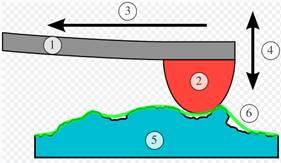
Principle of a contacting stylus instrument profilometer: A cantilever (1) is holding a small tip (2) that is sliding along the horizontal direction (3) over the object's surface (5). Following the profile the cantilever is moving vertically (4). The vertical position is recorded as the measured profile (6) shown in light green.
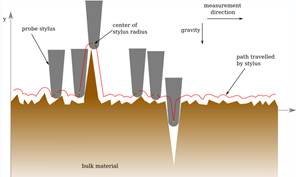
Sketch depicting how a probe stylus travels over a surface.
For 2D measurements, the probe usually traces along a straight line on a flat surface or in a circular arc around a cylindrical surface. The length of the path that it traces is called the measurement length. The wavelength of the lowest frequency filter that will be used to analyze the data is usually defined as the sampling length. Most standards recommend that the measurement length should be at least seven times longer than the sampling length. The assessment length or evaluation length is the length of data that will be used for analysis. Commonly one sampling length is discarded from each end of the measurement length.
Roughness Parameters. Each of the roughness parameters is calculated using a formula for describing the surface. There are many different roughness parameters in use, but Ra is by far the most common. Other common parameters include Rz, Rq, and Rsk. Some parameters are used only in certain industries or within certain countries. For example, the Rk family of parameters is used mainly for cylinder bore linings, and the motif parameters are used primarily within France. Since these parameters reduce all of the information in a profile to a single number, great care must be taken in applying and interpreting them. Small changes in how the raw profile data is filtered, how the mean line is calculated, and the physics of the measurement can greatly affect the calculated parameter.
Amplitude Parameters. Amplitude parameters characterize the surface based on the vertical deviations of the roughness profile from the mean line. Many of them are closely related to the parameters found in statistics for characterizing population samples. For example, Ra is the arithmetic average of the absolute values and Rt is the range of the collected roughness data points.
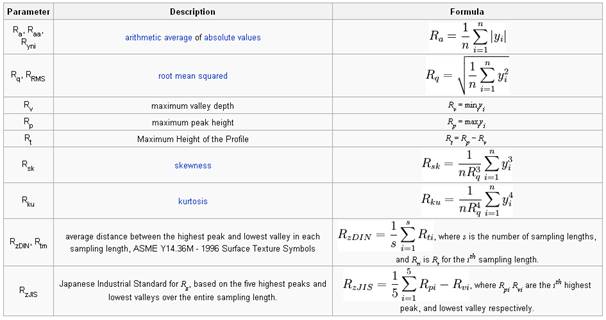
Specification
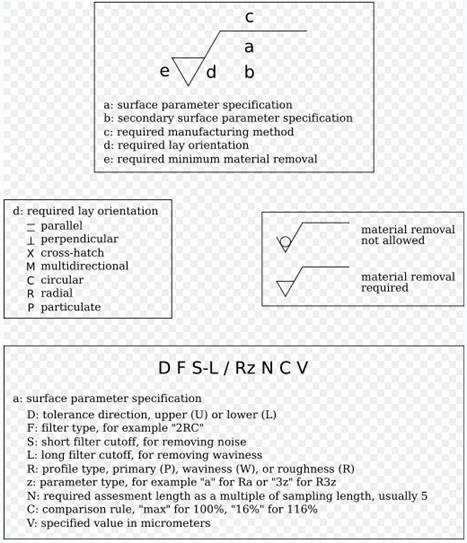
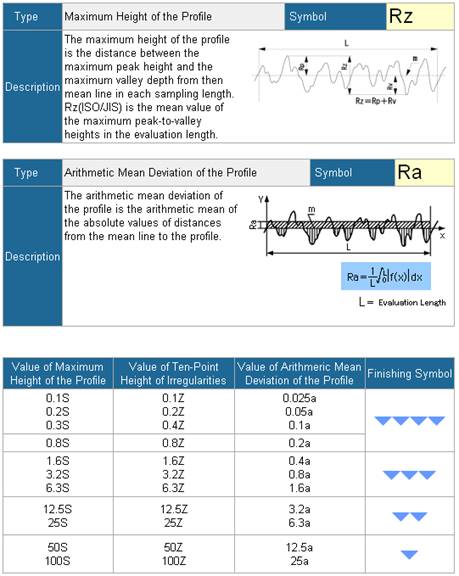
Formtracer CS-3000
Measurement with the Formtracer CS-3000: detection of surface roughness and
contour in a single, combined measuring sequence; evaluation and documentation
either separately or combined.
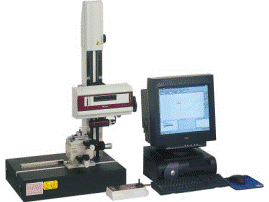
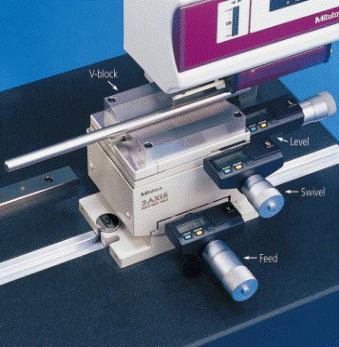
The complete program: surface and contour analysis at a glance with the standard analysis software FORMTRACEPAK, the Formtracer CS-3000 becomes a true multi-talent as far as operability and professional evaluation are concerned. FORMTRACEPAK unites the functions and qualities of the proven Mitutoyo softwares FORMPAK for contour measurement and SURFPAK for surface analysis.
Here, FORMTRACEPAK both makes separate detection and representation of surfaces and contours possible as well as combining evaluation of both measurement results, summarized in a single protocol. Of course, FORMTRACEPAK allows
for the creation of individual layouts and protocol heads as well as the integration of bitmap files.
PROCEDURES
REPORT FORMAT
Source: http://portal.unimap.edu.my/portal/page/portal30/Lecturer%20Notes
/KEJURUTERAAN_SISTEM_PEMBUATAN/KEJURUTERAAN_PEMBUATAN/DPT312METROLOGY/LABMODULE/LAB7%20(SURFACE%20ROUGHNESS).DOC
Web site to visit: http://portal.unimap.edu.my
Author of the text: indicated on the source document of the above text
If you are the author of the text above and you not agree to share your knowledge for teaching, research, scholarship (for fair use as indicated in the United States copyrigh low) please send us an e-mail and we will remove your text quickly. Fair use is a limitation and exception to the exclusive right granted by copyright law to the author of a creative work. In United States copyright law, fair use is a doctrine that permits limited use of copyrighted material without acquiring permission from the rights holders. Examples of fair use include commentary, search engines, criticism, news reporting, research, teaching, library archiving and scholarship. It provides for the legal, unlicensed citation or incorporation of copyrighted material in another author's work under a four-factor balancing test. (source: http://en.wikipedia.org/wiki/Fair_use)
The information of medicine and health contained in the site are of a general nature and purpose which is purely informative and for this reason may not replace in any case, the council of a doctor or a qualified entity legally to the profession.
The texts are the property of their respective authors and we thank them for giving us the opportunity to share for free to students, teachers and users of the Web their texts will used only for illustrative educational and scientific purposes only.
All the information in our site are given for nonprofit educational purposes